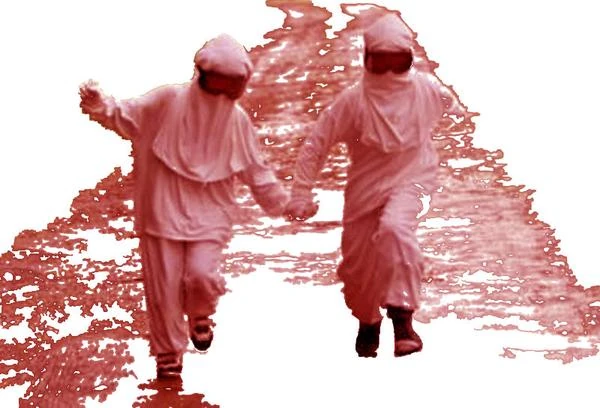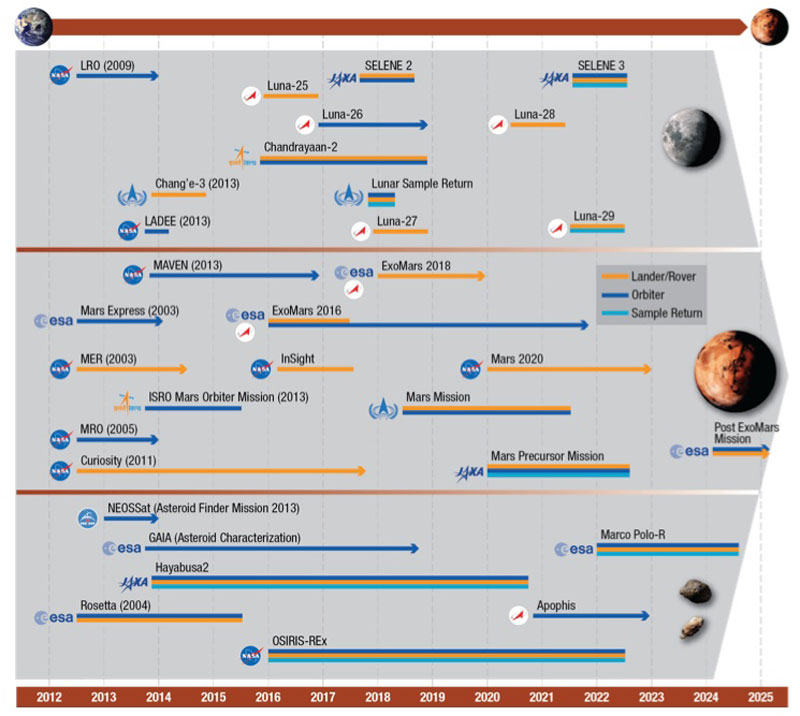
Image description: On Mars, solar radiation is harmful, like the children of the Moon, protection from the Sun will be necessary. Mars' thin atmosphere contains carbon dioxide and nitrogen. The atmospheric pressure is 0.6 KPa, on Earth 101 KPa. The gravity on Mars is 0.376 g (9.806 m/s2), on Earth 1 g. Mars' environment is particularly hostile, there is no oxygen and the temperature reaches -60°C on average. Image source: astronoo
The journey to Mars is an old dream for humanity, much more ambitious than the journey to the Moon achieved in the 1970s (Apollo programs).
What are the obstacles we face in 2014 to send humans to Mars and, more importantly, to bring them back in good health to our planet?
The obstacles are countless, but the main current barriers are technological, financial, and human. Going to Mars and returning to Earth is an impossible mission for the 2020s, given the numerous hurdles. To overcome these obstacles and acquire all the necessary technology, it will certainly take many decades.
As for living there, simulations like Mars 500 show the enormous technical and human complexity of such a mission. Since the 1960s, scientists have been studying the planet Mars through numerous past and ongoing space missions (Mars Global Surveyor, Mars Pathfinder, Mars Odyssey, Mars Express, Mars Exploration Rover, Mars Reconnaissance Orbiter, Phoenix, Mars Science Laboratory). Their probes and robots regularly present Mars' hostile environment and scientists now have a fairly precise idea of the history of its water, its climate, its subsoil, the potential dangers on the surface of Mars, possible landing sites for humans, and living conditions for a manned mission.
But this is not enough to go live on Mars; a number of intermediate missions will first need to be carried out to gradually acquire the technologies essential for the children of Mars. Moreover, the required budget being gigantic, a collaboration of global governmental and non-governmental organizations is essential. Just the one-way trip would cost 10 billion dollars. To go to Mars, one must be in good health, which is why the main concern of scientists is to preserve the health of the men and women who will travel in zero gravity.
In the 1970s, the Soviets with Soyuz 9 had tested long stays in space. After only 18 days, the bones and muscles of the cosmonauts had atrophied (30% muscle loss). Since then, in space stations, astronauts do a series of exercises for several hours a day to maintain their muscle mass, however, muscle loss remains significant (about 15% muscle loss every 300 days). But this is not the most worrying for health. The stress generated by long-duration trips is enormous and psychological balance is strongly disrupted by this isolation. The choice of men and women who will go will therefore be extremely selective as they will have to endure the shock for several years.

Image description: Since 1997, the Franco-Italian Antarctic base Concordia, located at an altitude of 3,233 meters, is one of the three research stations inside the Antarctic continent. The other two are the American base Amundsen-Scott and the Russian base Vostok. During the 9 winter months, Concordia hosts about fifteen people in total autonomy, in the coldest region of the world. In the foreground of the image, the polygonal buildings are placed on six hydraulic jacks to compensate for the variations in the level of the frozen ground and in the background the complete station (power plant, boiler room, water reserve, radio room, laboratory, bedrooms, kitchen, restaurant, library...). Although these scientists are on Earth, all their needs except oxygen are met by terrestrial assistance. To supply the people of Concordia, gigantic terrestrial and aerial transport means are used. About 350 tons of supplies arrive by three terrestrial convoys organized during the summer campaign. The isolation for a long duration of a small group of human beings is ideal for defining typical portraits in view of the exploration of the planet Mars.
To minimize the cost of the trip, the mission will have to last at least 15 years because the most favorable alignments between Earth and Mars (shortest distance) occur very rarely. The shortest distance between the two celestial bodies occurs when the planet Mars is in opposition, i.e., when the Earth is between Mars and the Sun. These oppositions occur approximately every 780 days (26 months), but given the respective eccentricity of the orbits of Mars and Earth, the shortest distance between Earth and Mars (55 million km) does not return every 26 months. It will be necessary to wait for the coincidence between the perihelion of Mars and the opposition of the two planets, i.e., 7 oppositions, i.e., 15 years. Under these favorable conditions, the astronauts will travel only 6 months for the outward journey and less than 4 months for the return, under the best conditions. The astronauts will be confined in a cramped capsule and the psychological aspect of this confinement is difficult to manage, not all human beings are capable of it, moreover, very few will endure it. A drastic selection of candidates will be necessary.
Living for months in perfect autonomy in a capsule requires bringing the oxygen, water, and food necessary for the journey. For a 9-month journey, the mass of oxygen, water, and food necessary is gigantic. Each day, a human consumes about 1 kg of food, 1 kg of oxygen, and 3 kg of water. To optimize the load, it will therefore be necessary to recycle water and waste and embark a mini terrestrial ecosystem that allows the survival of the crew during this long journey. For oxygen, it will be necessary to take the CO2 rejected and produce oxygen thanks to the photosynthesis of plants. For water, it will be necessary to recycle urine. For food, it will be necessary to recycle organic waste and then grow vegetables in the waste. Moreover, it will be necessary to ensure that no pathogenic organism invades the capsule. The psychological balance between men and women will be strongly tested. Although the astronauts will be confined in a cramped capsule, facing their confinement, the outward journey remains the simplest part of the mission.
Upon arrival on Martian soil, the candidates will have to be autonomous and, above all, stay healthy, and this task is much more complex than it seems. Mars' atmosphere is hostile, the luminosity is low, solar radiation is harmful, there is no oxygen, there is no liquid water, and the temperature reaches -60°C on average and can drop to -130°C. On Mars' desert soil, nothing grows, so it will be necessary to find water, produce energy, oxygen, water, and food in mini heated greenhouses. To build this, a lot of materials will be needed, which are absent on Mars. It will not be possible to bring the materials necessary to build a power plant, a boiler room, a water reserve, a wastewater treatment unit, a radio room, a laboratory, a workshop, offices, bedrooms, sports rooms, a kitchen, a restaurant, a library, etc... As for the return to Earth, this remains the most obscure part of the mission. A gigantic technological leap will be needed to consider it.
N. B. : MELiSSA (Micro-Ecological Life Support System Alternative) is a project whose objective is the study of an ecosystem of micro-organisms and plants. This tool allows for a better understanding of the behavior of artificial ecosystems and the development of technology for a future life support regeneration system for long-duration manned space missions, for example, a lunar base or a mission to Mars. The driving element of MELISSA is the recovery of food, water, and oxygen from waste (fecal matter, urea), carbon dioxide, and minerals. Based on the principle of an "aquatic" ecosystem, MELISSA is composed of 5 compartments colonized respectively by anoxic thermophilic bacteria, photoheterotrophic bacteria, nitrifying bacteria, photosynthetic bacteria, higher plants, and the crew. Hazardous waste and air pollutants are treated using the natural function of plants which in turn provide food and contribute to the purification of water and oxygen for air revitalization.

Image description: The idealistic roadmap for preparing a potential manned mission to Mars highlights the financial efforts to be made. The roadmap, which should lead to this objective, covers a period of 25 years and describes a sequence of necessary intermediate robotic and human missions.
A set of necessary missions in the lunar vicinity and on the surface of the Moon has been identified before considering a human mission to Mars for the 2030s. Ten space agencies met in Kyoto on August 30, 2011, as part of the ISECG (International Space Exploration Coordination Group) to discuss the development of a common roadmap for internationally coordinated space exploration. Before sending humans to Mars, it will be necessary to return to the Moon and send humans to an asteroid. Each of these objectives will allow space agencies to gradually acquire the technologies essential for reaching Mars. The roadmap for preparing a potential manned mission to Mars highlights the financial efforts to be made and the technological leaps to be achieved by global organizations. The sustainable, affordable, and productive exploration of the surface of Mars by humans is a very long-term objective. The global roadmap for the exploration of Mars creates a framework for the coordination of preparatory activities. This global Martian exploration roadmap is linked to a set of preliminary priorities and objectives to be respected, and there are not only technological objectives. Of course, it is necessary to develop exploration technologies and the infrastructure necessary for living and working beyond low Earth orbit.
But it is also necessary to engage the public in an interactive manner in a common cause such as space exploration. Human missions beyond low Earth orbit are only possible with coordinated international participation because the hurdles are considerable. A lot of expertise will be needed to enhance safety, extend human presence beyond low Earth orbit, continually increase the number of people on each destination, lengthen the duration of self-sufficient manned missions, reduce the risks of the space environment on human health and technological equipment, and finally highlight the benefits for all of humanity.
N. B. : The agencies that participated in the development of a common roadmap for coordinated space exploration are: ASI (Italy), CNES (France), CSA (Canada), DLR (Germany), ESA (European Space Agency), JAXA (Japan), KARI (Republic of Korea), NASA (United States), Roscosmos (Russia), UKSA (United Kingdom).